Slow Cognition: Mapping Thematic Landscape (Curativity, 2019 - 2022)

The Landscape of the "Curativity" Knowledge Enterprise
On April 26, 2021, I sent an email to a friend of mine and introduced my book The ECHO Way which reflects on my journey of writing three books in six months. I coined a new term called Slow Cognition to describe my favorite methods such as Howard E. Gruber’s evolving systems approach to creative work.
The Slow Cognition project aims to explore the historical-cognitive approach and the long-term development of thoughts. I used two strategies to conduct the project:
- I used my own real-life experience as data for the historical-cognitive analysis. In the past several months, I recorded ideas of my thoughts and wrote many articles on Medium. These records and articles represent the long-term development of my thoughts.
- I used Donald Schön’s Reflective approach to reflect on the development of my thoughts.
During the process, I also tried to develop some mapping methods for the project. Eventually, I developed several methods for the project.
Today I will review the method of Mapping Networks of Enterprise and introduce a new method called Mapping Thematic Landscape.
In order to discuss the outcome of knowledge production around a particular theme, I coined the term "Thematic Landscape" which refers to a landscape of personal explicit knowledge and related activities.
The core of the Mapping Thematic Landscape is a new type of diagram: Thematic Landscape Map. The mapping method can be used to 1) Reflect on Present Situations, 2) Discover Potential Themes, and 3) Explore Possible Projects.
I used my "Curativity" Thematic Landscape as an example to design the map and develop the method.
Contents
1. Mapping Networks of Enterprise
2. Mapping Thematic Landscape
3. Primary Theme and Secondary Themes
4. Five Knowledge Centers
5. Curativity Center
6. Life Strategy Center
7. Activity Analysis Center
8. Platform Ecology Center
9. Discovering Potential Themes
10. Exploring Possible Projects
11. Conclusion
(Total 6,456 words)
1. Mapping Networks of Enterprise
In order to conduct a mini-research for the Slow Cognition project, I selected the following 12 significant insights as samples in May 2022. I also use a set of questions to discuss each insight. You can find more details here.
There are two questions about the “insight — activity” relationship:
- Activity: Is this insight part of an activity? What’s the activity?
- Activity: Has this insight led to a new action or a new activity?
On May 24, 2022, I published a summary of the mini-research project. However, I didn’t discuss the above two questions because it requires more time to analyze the network of activities.
On May 25, 2022, I started mapping the "insight-activity" network. See the screenshot below.

To be honest, it is a challenge to visualize the complex relationship between the 12 significant insights and related actions, activities, projects, and themes.
In the beginning, I adopted Howard E. Gruber’s evolving systems approach as the foundation for the mapping. See the diagram below.

I also tried to use other models. However, I returned to Gruber’s model later. See the screenshots below:
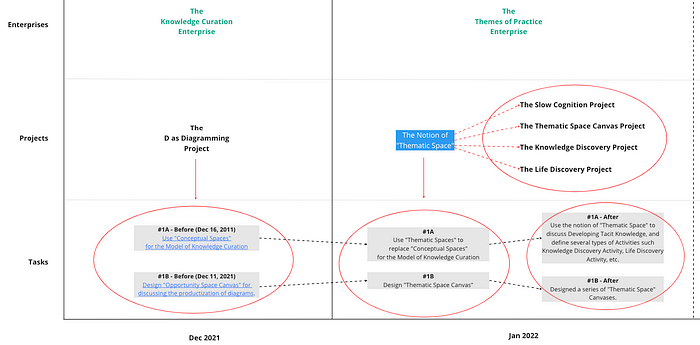

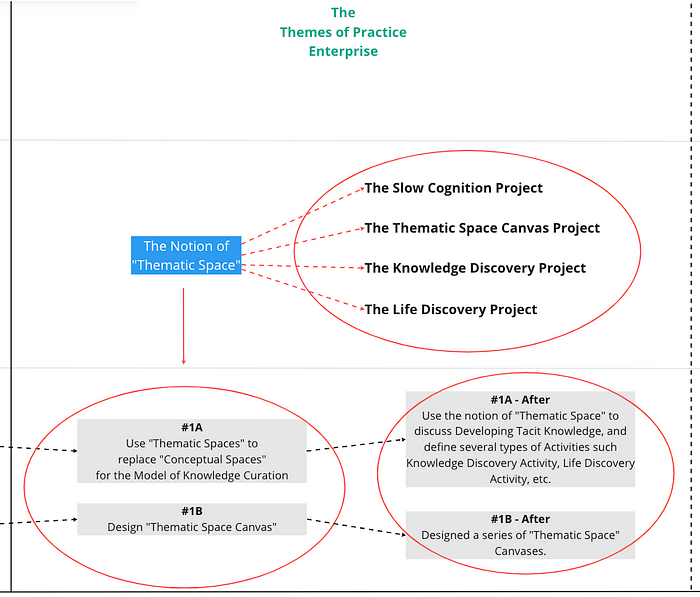
What I learned from the draft is that there are different amounts of data in four levels. The “Networks Enterprise” level and the “Enterprise” level have a few keywords while the “Project” level and the “Task” level have rich data.
This project is a new version 2.0 of Mapping Networks of Enterprise. The diagram below is version 1.0 of Mapping Networks of Enterprise, you can find more details here.

What’s the difference between version 1.0 and version 2.0 of Mapping Networks Enterprise?
Version 1.0 focuses on the “Enterprise” level and the large timescale while version 2.0 is more above the “Project” level and the small timescale.
2. Mapping Thematic Landscape
On Sept 2, 2022, I developed a new method called Mapping Thematic Landscape for the Slow Cognition project. This method is different from a previous method called Mapping Thematic Spaces.
Several months ago, I coined a term called Thematic Space and developed a canvas for Mapping Thematic Spaces. You can find more details in Knowledge Discovery (Book): Developing Tacit Knowledge with Thematic Space Canvas.
A thematic space refers to a person’s ideas, activities, and practices around one particular theme. A theme can be an established theory such as “Activity Theory”; or a normal concept such as “Platform”, “Life”, etc; and an idea in the middle, such as “design thinking”, “UX”, etc.
The below canvas is the Thematic Space Canvas. It led to a set of canvases.
- The Thematic Space Canvas
- The Spark Space Canvas
- The Statue Space Canvas
- The Life Discovery Canvas
- The Optimal Context Canvas
- The Lifesystem Development Canvas

You can find more details in Slow Cognition: A Meta-canvas for Developing Tacit Knowledge.
I made a distinction between Knowledge Discovery and Knowledge Production. While the outcome of Knowledge Discovery is Significant Insight, the outcome of Knowledge Production is Knowledge Products. Moreover, Significant Insight will lead to Knowledge Production. From the perspective of the Anticipatory Activity System framework, Knowledge Discovery is the Second-order Activity while Knowledge Production is the First-order Activity.
Knowledge Discovery (book) focuses on developing tacit knowledge. The method of Mapping Thematic Space is for understanding the development of tacit knowledge.
In order to discuss the outcome of knowledge production around a particular theme, I coined the term "Thematic Landscape" which refers to a landscape of personal explicit knowledge and related activities.
On Sept 2, 2022, I used my "Curativity" Knowledge Enterprise as an example to develop the "Thematic Landscape" method. The final result is a large diagram. See the screenshot below.
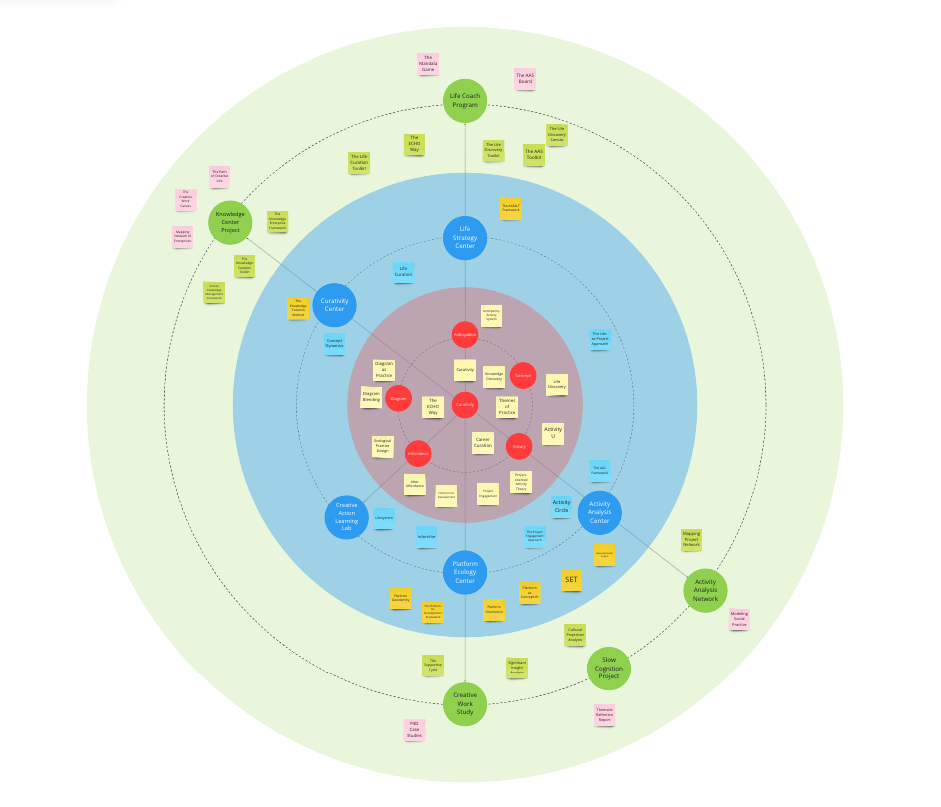
The method uses three nested circles as a basic model.
- Theme: this inner circle is for displaying Themes and Books.
- Work: the middle circle refers to Projects and two types of Knowledge Frameworks: Abstract Models and Concrete Models.
- Play: the outer circle is about Programs that consider two types of things: Tools and Actions.
While the Theme circle and the Work circle are about knowledge makers' individual work, the Play circle refers to the collaborative space between knowledge makers and knowledge users.
These three circles also have different significant aspects of complexity.
- Theme: the cognitive aspect of complexity is the primary challenge.
- Work: the material aspect of complexity is the primary challenge.
- Play: the social aspect of complexity is the primary challenge.
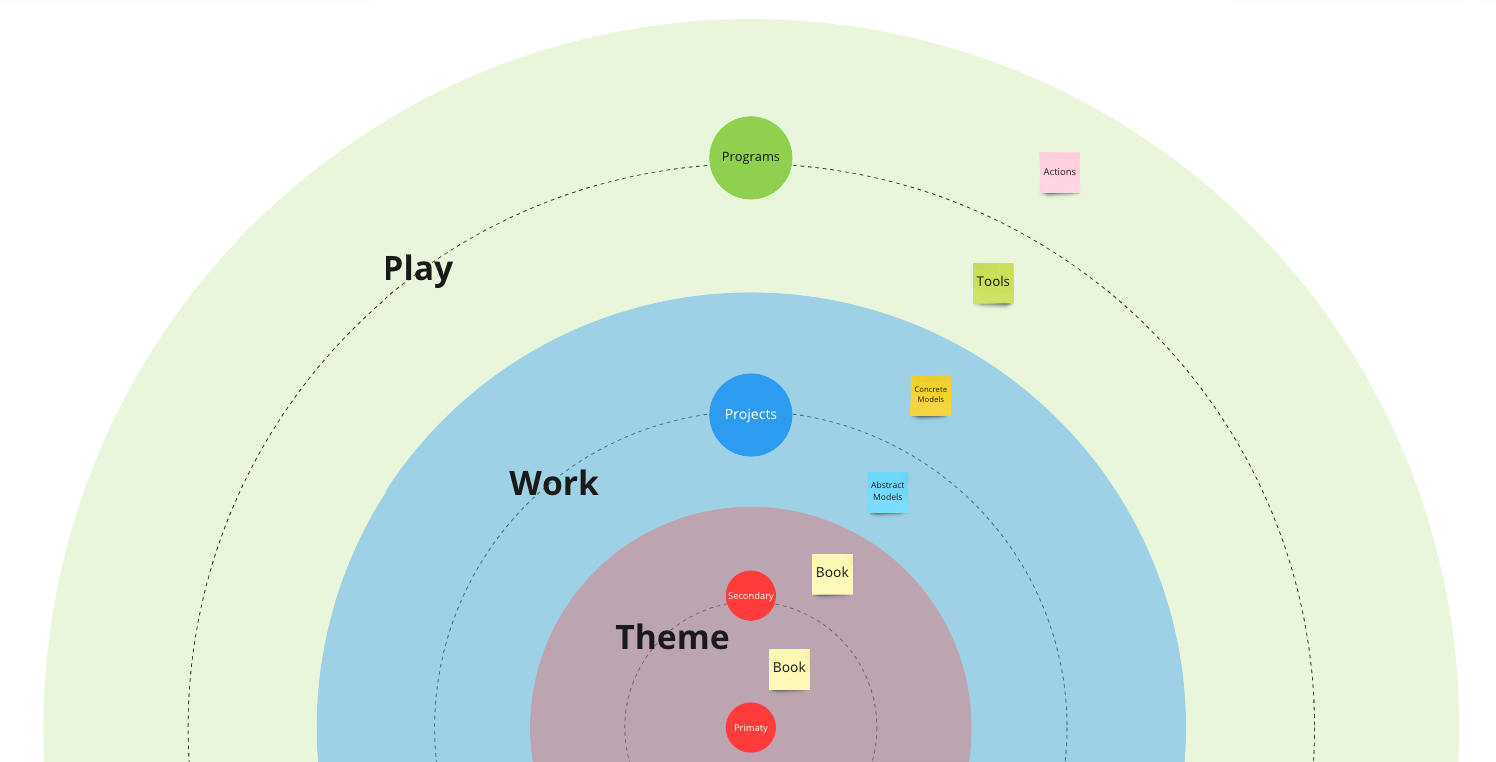
The above model is inspired by a model of Project-oriented Activity Theory. It represents three types of Objectification of a Concept:
- Symbolic Objectification: “Verbal” and “Visual”
- Instrumental Objectification: “designed” and “found”
- Practical Objectification: “Branded” and “Shared”

On May 29, 2022, I used two models to expand the concept of "Objectification" and build a framework:
- The Movements of Objectification of Platform-core (Three types)
- Construal Levels of Platform Objectification (Six levels)
If we combine these two together, we can generate a 3x6 matrix. See the chart below.

I use “Curativity” as an example of the meta-theory. Though the concept of “Curativity” is a member of the Ecological Practice Approach, it led to a series of projects such as the Knowlege Curation project, the Life Curation project, and the Career Curation project. My “Curativity” thematic space became a large knowledge enterprise.
However, the chart is not useful for mapping more data and sensemaking. I need a creative space to support Diagramming as Thinking.
Today I will use the method of Mapping Thematic Landscape to review the landscape of my "Curativity" knowledge enterprise.
3. Primary Theme and Secondary Themes
The primary theme of my "Curativity" knowledge enterprise is the concept of "Curativity".
I have worked in the curation field for over ten years. I was the Chief Information Architect of BagTheWeb.com which was an early tool for content curation (We launched the site in 2010). This experience inspired me to make a long-term commitment to the Curation theme. After having 10 years of various curation-related practical work experience and theory learning, I coined a term called Curativity and developed Curativity Theory which became a book.
The core idea of Curativity Theory is very simple:
In order to effectively curate pieces into a meaningful whole, we need Container as part to contain pieces and shape them.
The theory built a brand new ontology called “Whole, Piece and Part” and adopted James Gibson’s “Affordance”, George Lakoff’s “Container” and Donald Schön’s “Reflection” as epistemological tools. To test the theory, I wrote several case studies and one of them is titled Knowledge Curation.
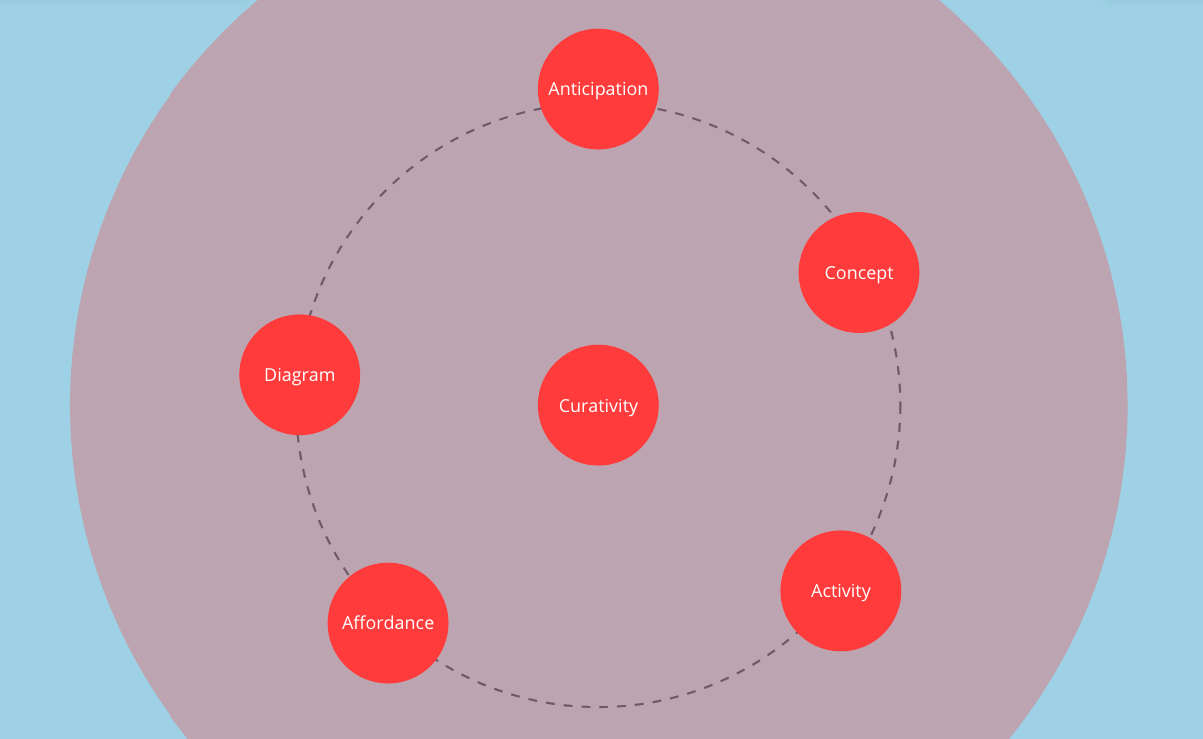
In March 2019, I finished a 615-page Google doc file which is titled Curativity: The Ecological Approach to General Curation Practice.
After March 2019, I continuously worked on revising Curativity. For the direction of Curativity Theory, I am looking for practical applications, for example:
- Knowledge Curation
- Action Curation
- Life Curation
- Platform Curation
In August 2020, I started the Knowledge Curation project and the first sub-project is the Activity U project. The journey led to the following secondary themes:
- Affordance
- Activity
- Anticipation
- Concept
- Diagram
The "Affordance" theme refers to Affordacne Theory which is a core idea of Ecological Psychology. As mentioned above, I adopted James Gibson’s “Affordance”, George Lakoff’s “Container” and Donald Schön’s “Reflection” as epistemological tools for Curativity Theory. Originally, I called it the "Gibson-Lakoff-Schön" solution. Later, I renamed it the Ecological Practice Approach.
The "Activity" theme refers to Activity Theory or CHAT (Cultural-historical activity theory) which is an interdisciplinary philosophical framework for studying both individual and social aspects of human behavior. I started the Activity U project on August 19, 2020. Initially, I just made a diagram called “Activity U” which is a test of a framework. Later, It expanded from one post to a series of articles and two books. Eventually, it led to a three-year journey.
The "Anticipation" theme refers to the Anticipatory Activity System (AAS) framework which is inspired by Activity Theory and Robert Rosen's Anticipatory Systems theory. The AAS framework aims to offer an abstract model for understanding "Self, Other, Present, Future". While the traditional Activity Theory focuses on "Exploitative Activity", the AAS framework is more about "Exploratory Activity".
The "Concept" theme refers to my 2021 book Project-oriented Activity Theory and the Themes of Practice framework. Project-oriented Activity Theory follows Andy Blunden's approach to an interdisciplinary theory of Activity Theory. The core idea of Blunden's approach is the notion of “Activity as Formation of Concept” which echoes my own idea of "Themes of Practice".
The "Diagram" theme refers to the D as Diagramming project which produced two books (drafts) about diagrams and diagramming as practice. Diagrams are one of my favorite practices. I love to dwell in thought with diagramming. I even wrote a 108-page thesis that develops a theory about diagrams and diagramming in 2018. I consider two groups of ideas for my theory about diagrams. The first group is “meta-diagram, diagram, and diagram system” and the second group is “diagramming as an activity of knowing, theorizing, and reflecting”. These two ideas led to two books in 2021.
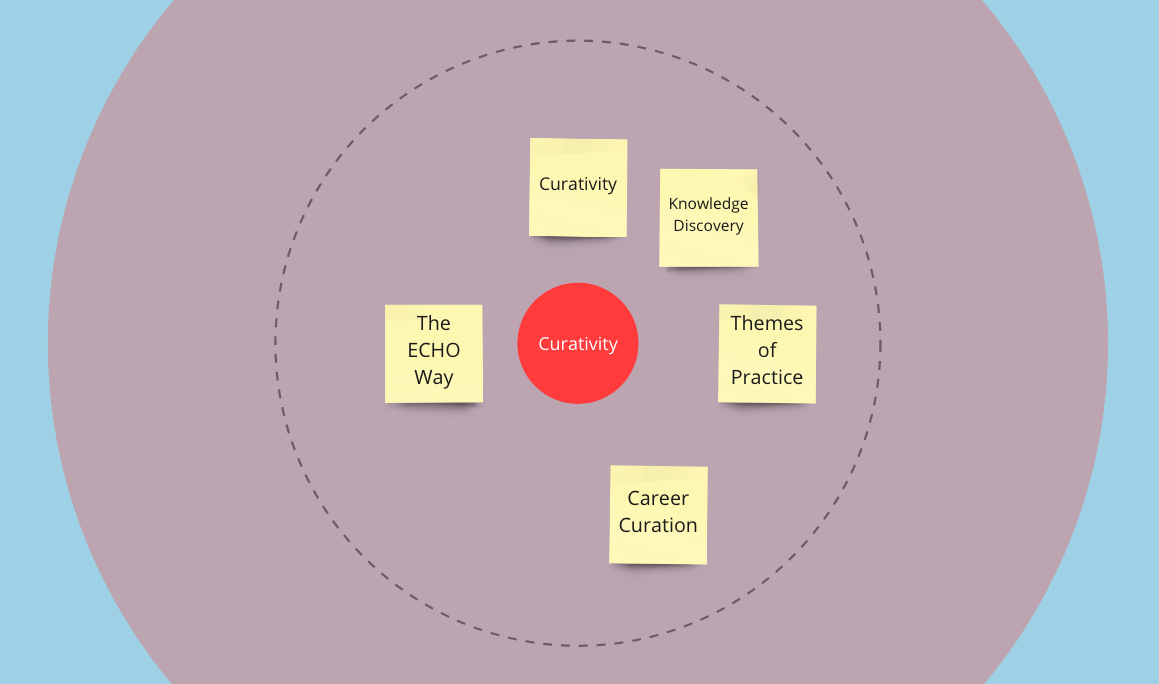
From 2019 to the present, Curativity Theory led to five possible books (drafts):
- Curativity
- The ECHO Way
- Themes of Practice
- Career Curation
- Knowledge Discovery
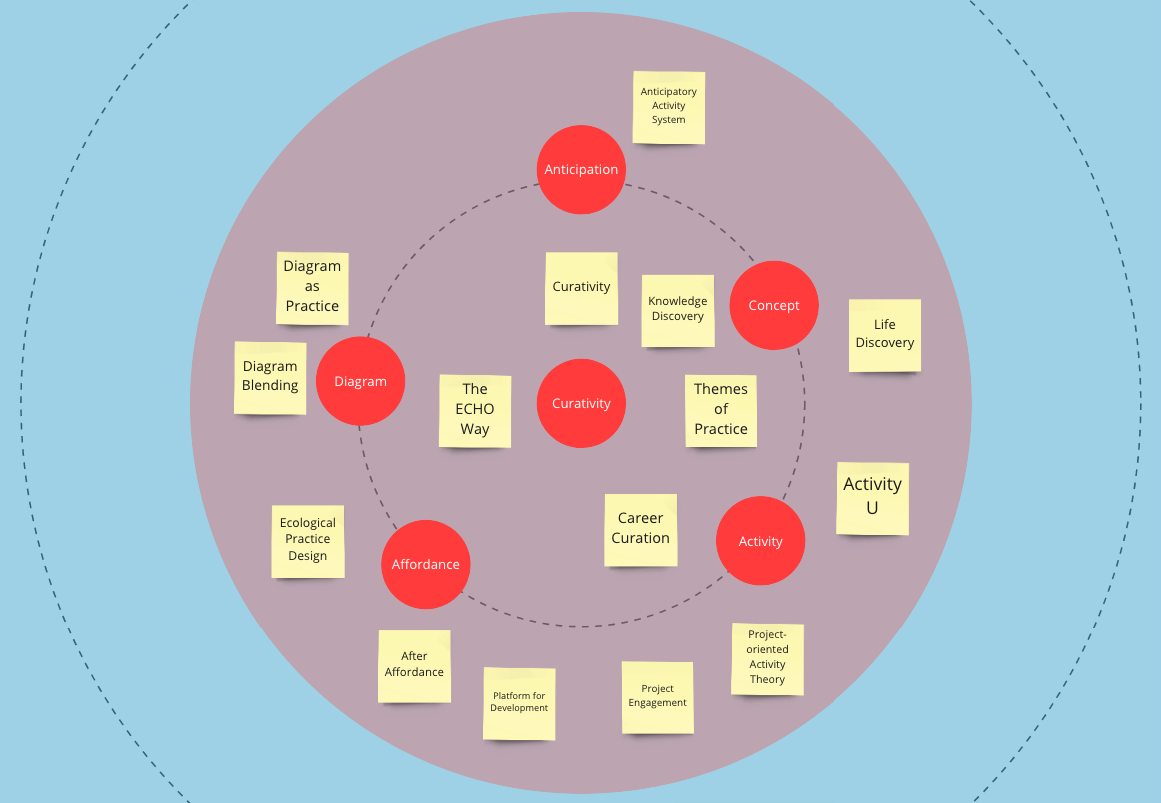
The five secondary themes led to 8 possible books.
- After Affordance
- Platform for Development
- Activity U
- Project-oriented Activity Theory
- Diagram as Practice
- Diagram Blending
- Life Discovery
- Ecological Practice Design
I also wrote plans for the following two theoretical approaches:
- Project Engagement
- Anticipatory Activity System
You can find more details in Meet with Oliver Ding: 1 Mission, 4 Theories, and 12 Possible Books.
4. Five Knowledge Centers
Though the method is developed for the Slow Cognition project, it is also useful for my newest project: the Knowledge Center project.
In the past three years, I worked on Developing Knowledge Themes. This year I moved to the next stage: Building Knowledge Centers.
I am currently running five knowledge centers.
- Curativity Center
- Activity Analysis Center
- Creative Action Learning Lab (CALL)
- Platform Ecology Center
- Life Strategy Center
CALL was founded in Sept 2019 and its original purpose is hosting a Medium publication for my articles about creative actions and other topics. In 2020, CALL became a Knowledge Curation Studio that produces a set of knowledge frameworks and builds an ecology of ideas. I also wrote seven books which are drafts. In addition, I worked on four independent research projects in order to test concepts and frameworks. See more details in CALL: Annual Review (2020–2021).
In April 2022, I reflected on the development of CALL and made a diagram below.

The above screenshot refers to a new mission of CALL:
Building a supportive ecosystem for knowledge creators.
The mission considers Building Knowledge Enterprise Activity as the core of the supportive ecosystem.
Originally, I developed the following model for the Activity Analysis project. Later, I realized that it can be a general model for building knowledge enterprise activity. The model aims to answer a related question:
How to grow a knowledge enterprise?

The model is inspired by Project-oriented Activity Theory. Each phase refers to a focus. The three-phase development is inspired by the following diagram which is one of a series of diagrams in the book.

I used the above diagram to explain the concept of “culture” from the perspective of Project-oriented Activity Theory. It zooms out to a large view that connects the Individual mind (Idea) and Collective theme (Zeitgeist) through Collective Projects (Concept).
The about diagram also mentions three knowledge frameworks I am working on:
Each knowledge framework could be adapted to support one phase of the Building Knowledge Enterprise (BKE) Activity.
You can find more details in the following articles:
- May 6, 2022 - CALL: How to Grow A Knowledge Enterprise
- May 29, 2022 - Platform Genidentity: The Movements of Unfolding Uniqueness
- June 2, 2022 - CALL: The Launch Day of Curativity Center
- June 7, 2022 - How Does Collective Learning Work?
- July 12, 2022 - CALL: Creativity, Opportunity, and Possible Practice
- August 5, 2022 - Activity Analysis Center: Curativity, Creativity, and Activity
My current focus is running a Project Network of five knowledge centers. This is a new challenge for me. I need to explore some new tools for managing the complexity of running multiple knowledge centers.
This challenge goes beyond Howard E. Gruber’s "Networks of Enterprise" theory which refers to the evolving systems approach to creative work. But it echoes the Project Engagement approach's v2.1 version which considers the notion of "Project Network". In other words, I am working on testing the Project Network module while running five knowledge centers.
Thus, the Mapping Thematic Landscape method contributes to both the PRACTICE side and the THEORY side.
5. Curativity Center
Though I wrote a book titled Curativity and developed Curativity Center in 2019, I didn't establish Curativity Center in 2019. I run several Knowledge Curation projects under CALL from 2020 to May 2021.
On June 2, 2022, I launched a new Medium publication for Curativity Center on Medium. I also made a homepage for Curativity Center on Milanote.

For the past three years, CALL was the incubator of the above five knowledge centers. Curativity Center was born from CALL.
On June 2, CALL and Curativity Theory exchanged their positions. In the future, Curativity Center will be a meta-center for building the network of knowledge centers.
As a meta-center, Curativity Center aims to build a supportive ecosystem for knowledge creators. It is currently working on the following three internal projects:
- 1) curating a series of knowledge curation projects, and
- 2) developing a series of tools for knowledge curation activity and related activities such as knowledge management and knowledge service.
- 3) supporting the other four knowledge centers.
Curativity Center considers Building Knowledge Enterprise Activity as the core of the supportive ecosystem.
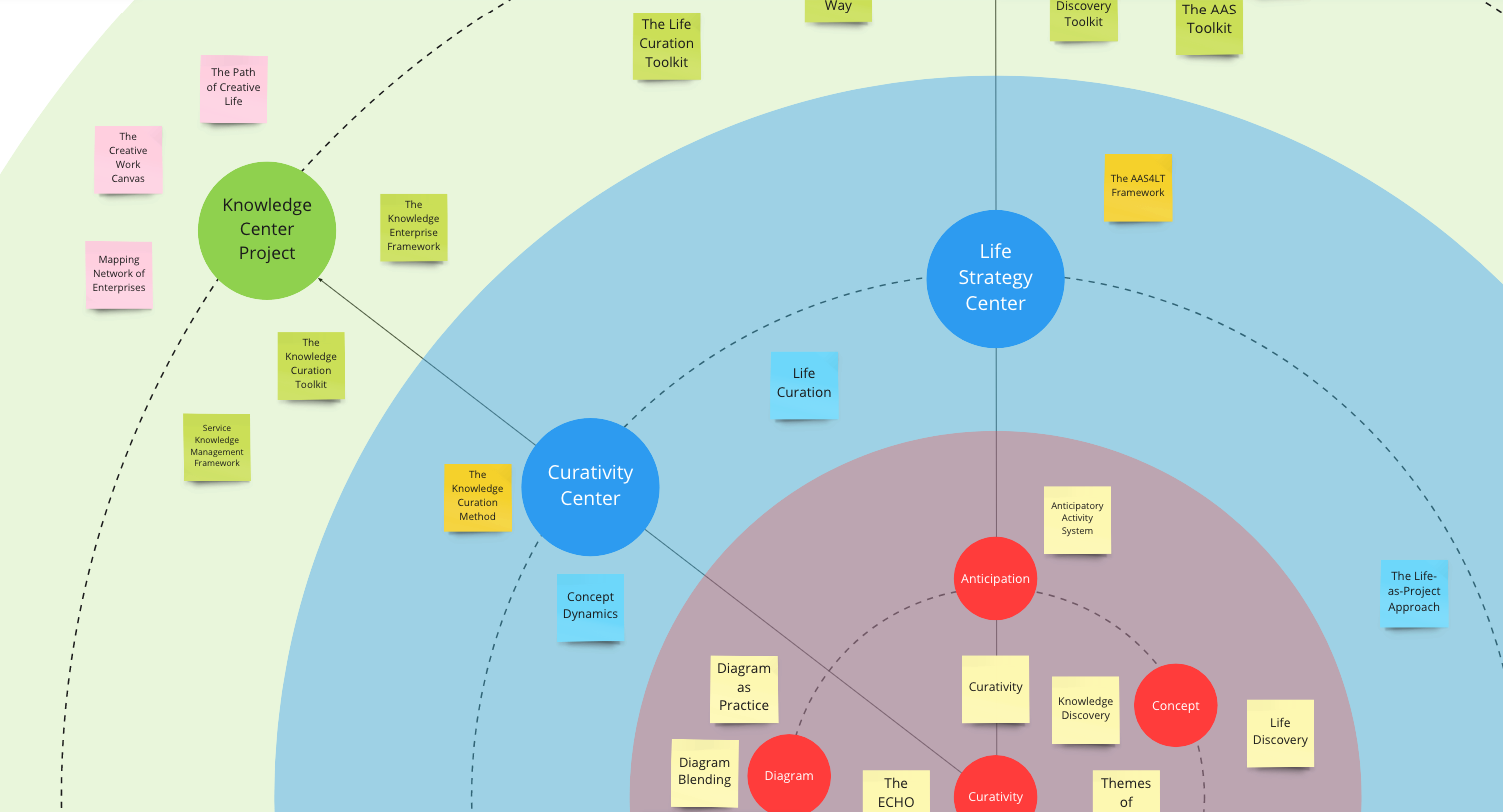
The above screenshot is part of the large diagram of the "Curativity" Thematic Landscape.
As mentioned above, I currently focus on building multiple Knowledge Centers. For Curativity Center, it means the Knowledge Center project.
You see a connection across three levels:
- Curativity > Curativity Center > The Knowledge Center Project
You also see an area between Curativity Center and Life Strategy Center. There is an Abstract Model there.
- Life Curation Framework
From the perspective of Curativity Theory, Life Curation Activity is a significant activity of adult life development.

I developed the Life Curation Framework in Dec 2019. Now it can be a collaborative project between Curativity Center and Life Strategy Center.
Why do we need the Thematic Landscape method?
Because we can use Spatial Affordances to help us discover more potential collaborative projects between multiple knowledge centers.
In this way, we can effectively build a Project Network of several connected Knowledge Centers.
6. Life Strategy Center
A major change in my "Curativity" knowledge enterprise is the "Life - Strategy" Thematic Curation project and Life Strategy Center.
In Jan 2022, I was busy dealing with friends' requests for practical suggestions about life strategies. I framed the notion of "Life Strategy" as a practical toolkit.
On Jan 29, 2022, I had a significant insight about the notion of "Life Strategy". I realized that I could detach the notion from the “toolkit” and attach it to the “dialogue”: The Life - Strategy Thematic Dialogue.

The Thematic Space Canvas visualizes this moment.
- Before: the focus of my mind is on the “Heuristics” block which belongs to the PRACTICE Field.
- After: the focus of my mind moves to the “Approaches” block which belongs to the THEORY Field.
- Then: the new focus led to a new project which is on the “Projects” block.
From Jan to June, I worked on several related projects such as:
- The Life Discovery Toolkit
- The Life Discovery Canvas
- The Life-as-Project Approach
- The AAS4LT Framework
- The AAS4lt Life Coach Program
These activities contribute to both the THEORY side and the PRACTICE side. In July, I updated the Project Engagement approach from v1.0 to v2.1. In August, I reviewed the development of the Anticipatory Activity System (AAS) framework and a TOC for a possible book.
In order to support further development of these ideas, I launched Life Strategy Center on Coda on August 25, 2022.
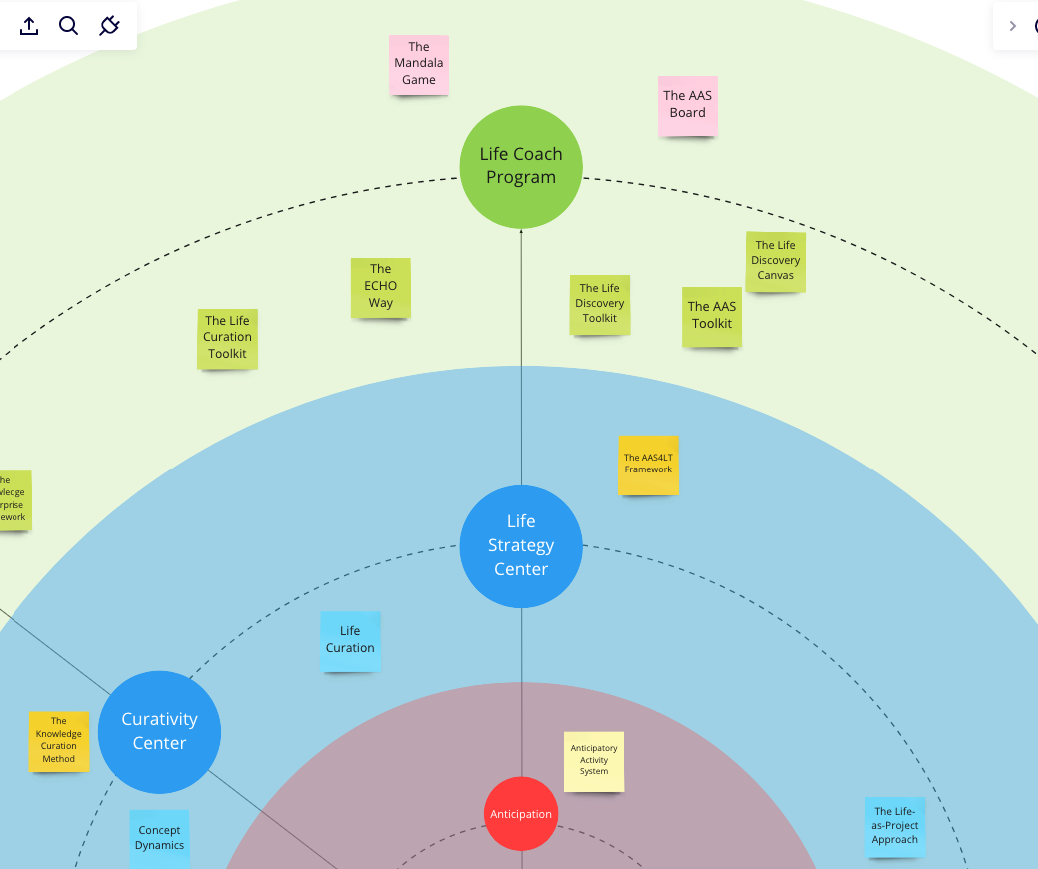
The primary task of the Life Strategy Center is to apply the Anticipatory Activity System (AAS) framework to Life Strategy Activity, Life Curation Activity, and Life Development in general.

The Anticipatory Activity System (AAS) framework is an expanded version of iART Framework which was born from an empirical research project about an adult development program. I call the program SSL which stands for Shaper & Supporter Lab. Anyway, it is just a codename. SSL was founded by a friend of mine in April 2021.
The program was designed with three components: 1) Life Purpose Awareness, 2) Personal OKR Practice, and 3) Peer Review and Feedback.
In the past 12 months, I used the Project Engagement approach to guide my research about the program. The outcome is the AAS framework and related sub-frameworks.
I also used the Knowledge Curation approach to guide the development of the AAS project. The diagram below is based on Theme U which is a tool of the Knowledge Curation toolkit.

"Anticipatory Activity System" is a specific theory inspired by Activity Theory, Anticipatory System theory, Relevance theory, etc. It defines the basic model of the AAS framework.
The #AAS4LT framework is an 8-step framework for applying AAS to Life Transitions (LT). It considers “Life Discovery Project” as Second-order Activity and “Life Developmental Project” as a First-order Activity. This is a concrete model.

At the domain practice level, I designed and hosted the AAS4LT 1:1 life coaching program on Milanote which is a digital whiteboard.

The AAS project presents a complete example of the cross-level practice of Knowledge Enterprise.
- Curativity > Anticipation > Life Strategy Center > Life Coach Program
You can also see Abstract Model, Concrete Model, Tools, and Actions on the above screenshot of the diagram.
7. Activity Analysis Center
The Activity Analysis Center has been launched as a demo of the idea of “Knowledge Center”. It is phase II of the Activity U project.
I started the Activity U project on August 19, 2020. Initially, I just made a diagram called “Activity U” which is a test of the “HERO U” framework. I wrote a post to explain the diagram “Activity U”. Later, I expanded the post to a series of articles. Eventually, I edited these articles into two books (draft).
- Activity U: How to Think and Act Like an Activity Theorist (2020)
- Project-oriented Activity Theory (2021)
You can also find the historical development of the Activity U project on Milanote.

Originally, I wanted to launch the Activity U project (II) in Oct 2021. I mentioned the idea on Oct 7, 2021 with the above diagram.
The next day I created a new website called Activity Analysis because I didn’t want to call the website the Activity U project (Phase II).
The Activity Analysis project was born.
Originally, the Activity Analysis Project was designed with the following two components:
- A mini digital knowledge library about Activity Theory and other Social Practice Theories for practitioners.
- A mini digital magazine about activity-theoretical inspired mini case studies.
However, I was busy on the D as Diagramming project from Oct 2021 to Dec 2021. So, I decided to launch the project later.
During Nov 2021 and Dec 2021, I worked on closing the D as Diagramming Project (Phase I). In order to summarize the insights I learned from the project, I developed an integrated framework for studying knowledge diagrams.

The above diagram shows four conceptual spaces which are named the “Architecture” space, the “Relevance” space, the “Opportunity” space, and the “Activity” space. Each conceptual space refers to a set of similar theoretical approaches.
On Dec 16, I changed my view on the Activity Analysis project. Since the “Activity” conceptual space became a part of an integrated framework. I no longer see Activity Theory as an object for working on. For me, it can work with other theoretical approaches together.
I realized that the Conceptual Space is a great notion because it highlights the important zone of the Objective — Subjective Knowledge Curation.
Building and developing a Conceptual Space means Objective — Subjective knowledge curation. You need to connect established theories with your own personal life/work experience. There is a lot of work to do for this type of knowledge curation. You have to select theoretical approaches and identify the similarities and differences between various theories. You have to reflect on your own experience and imagine your future work in order to find relevant themes to curate theoretical approaches. Finally, you need to name your conceptual spaces.
By working on building four and more conceptual spaces, I develop my tacit knowledge into a curated mind with a curated epistemological framework and a set of models, diagrams, and canvases.
Thus, the Activity Analysis project has a new meaning for me. It could be a digital space for turning my personal “Activity” conceptual space into a public collective “Activity” conceptual space.
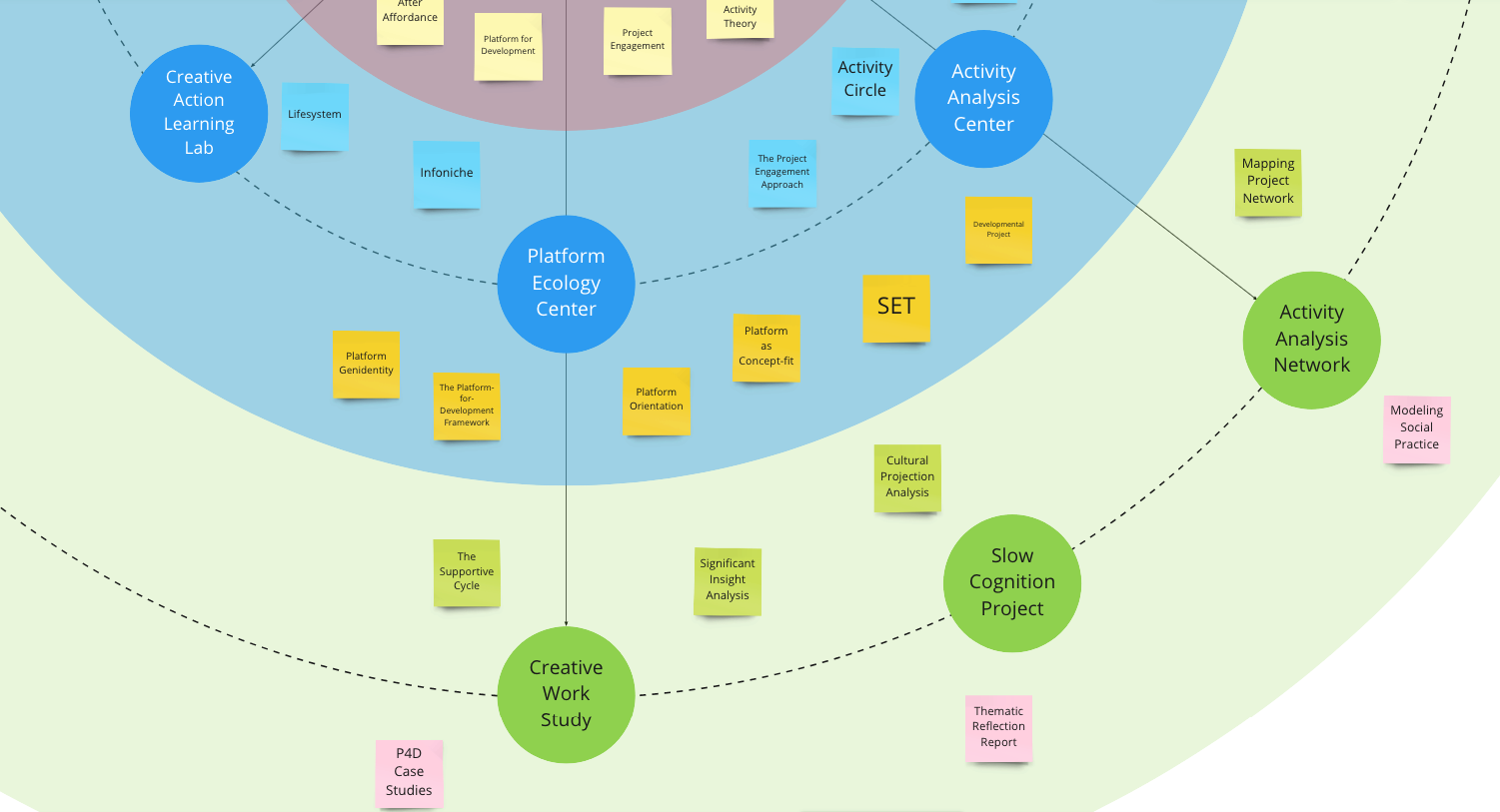
On Jan 2, 2022, I had a 71-minute talk with a friend of mine. He is an active curator of early local TEDx events in China. In recent years, he also curated local Design Sprint events in China. In addition, he often curates innovation workshops for local communities.
I briefly introduced the development of my personal studio CALL in the past year. Before the talk, he read the article CALL: Annual Review (2020–2021). The major part of our talk focused on my work on Activity Theory.
At the end of the talk, we chatted about the future of CALL in 2022. I mentioned the Activity Analysis project. I told him that I’d like to run it as a Knowledge Center.
The notion of Knowledge Center is a new spark for me. I didn’t use the term to describe the Activity Analysis project before the talk. As a new spark, it emerged from a conversation.
On Jan 13, I designed the diagram below to visualize what I talked about the notion of Knowledge Center with my friend on Jan 2.

The above diagram describes an imagined project with a new concept.
- An imagined project: the Activity Analysis project
- A new concept: Knowledge Center
Now, the Activity Analysis project is a website that refers to my “Activity” thematic space. The website is just about an idea that belongs to an individual mind.
In the next phase, the Activity Analysis project is expected to grow as a knowledge center as a collective project. That means it is not my personal idea, but it should be a concept shared by a group of people who are passionate about adopting the “Activity” thematic space for their epistemic development. Also, they would like to contribute to the development of the collective “Activity” thematic space.
Phase 3 is building a Knowledge Community. The difference between Knowledge Center and Knowledge Community is Scope and Scale. A knowledge center may only have less than 15 members while a knowledge community may have thousands of members.
Though each knowledge center has its own historical developmental trajectory, we can use the following cross-level pattern to understand the structure of the Knowledge Enterprise.
- Curativity > Activity > Activity Analysis Center > Activity Analysis Network
As discussed above, there is a move between Activity Theory and the "Activity" thematic space which refers to more social practices.
8. Platform Ecology Center
One application of the Ecological Practice approach is the Platform for Development framework which refers to an intersection between digital platform and adult development. I have been paying attention to these two domains for over ten years. As a participant in digital platforms, I am both a user, a curator and a maker. As a participant in adult development, I have founded several non-profit online communities which aim to support the life development of university students and young professionals.

In the past several years, I also developed several models to guide my reflections on practical experiences on digital platforms and adult development. For example, I was attracted to biographical studies since I wrote my first learning autobiography in 2015. In order to help a friend, I developed a framework called Career Landscape which is inspired by Activity Theory, Communities of Practice, and other ideas in 2016. I recently reconstructed the framework with more theoretical resources and the outcome is a new method named the Life-as-Activity approach.
On the other side, I have been working on developing several models for reflecting on digital platforms. I shared these models with my co-workers and friends. In 2019, I started sharing some models on Medium. The Social Platform Experience Design (#SocialPxD) framework is the first one.
However, these models are separate. The Platform for Development is my first model which combines these two topics together. The major theoretical resources behind the framework are Activity Theory (the project-oriented approach, Andy Blunden, 2014), Social Domains Theory (Derek Layder, 1997), Ecological Psychology (James Gibson, 1979), and Self-Determination Theory (Edward Deci and Richard Ryan, 1971, 2017). I was also inspired by Knud Illeris’ How We Learn (2007) and John Hagel’s The Power of Platform (2015).
Though the original inspiration of the Platform for Development framework is digital platforms, I don’t want to limit the scope of the framework inside the domain of digital technological platforms. The P4D framework is expected to apply to various domains such as Startup Ecosystem, Brand and Communication, Community Engagement, Content Curation, Theoretical Traditions, Knowledge Platforms, etc.
In other words, I need an interdisciplinary definition of “Platform” for this framework. Thus, I defined a new concept called Developmental Platform in order to avoid misunderstanding.
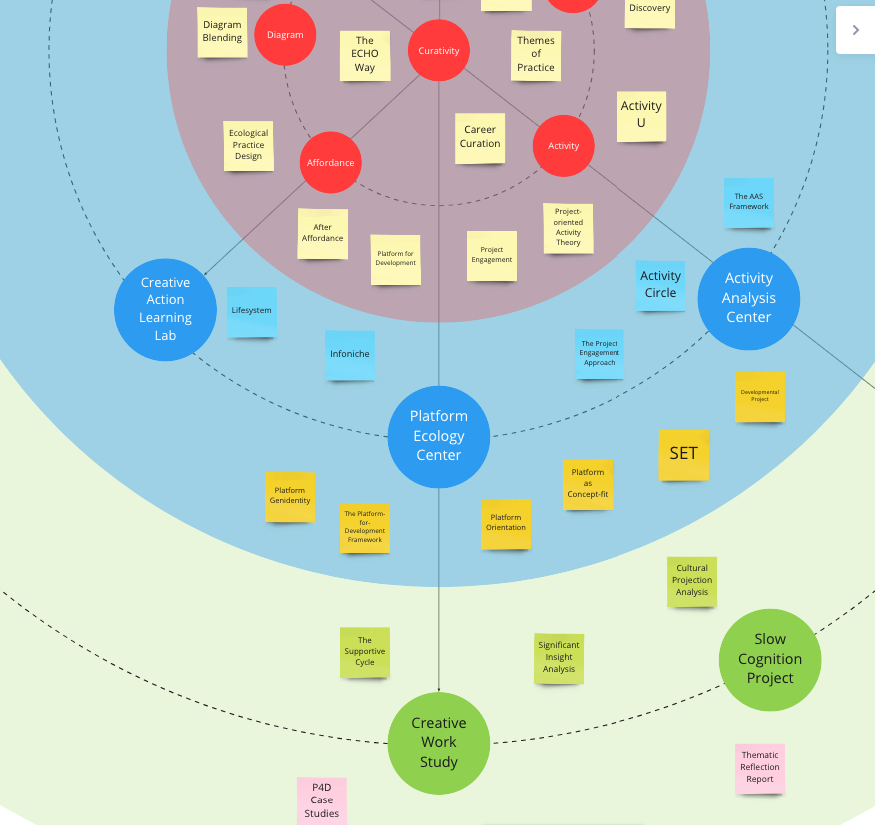
In fact, the Platform Ecology Center aims to explore the ecological approach to Platform-based Social Practices. You can find more details in Platform, Platform-ba, and Platform Ecology.
I have written a brief on the Ecological Practice Approach on Oct 19, 2020. Here we just review the part about Container, Network, and Platform.
Based on the concept of Container, I developed two related ideas: Network and Platform.
- The Network refers to the pre-container status which means pieces loose coupling outside a container.
- The Platform refers to the post-container status which means pieces loose coupling within a super large container.
These three ideas form a triad: Network — Container — Platform. I consider the triad as the basic form of collective context for applying the Ecological Practice approach.

The above diagram represents a large map of the ecological practice approach. Here we see three basic types of collective context and attaching/detaching acts inside contexts and between contexts.
In the above diagram, we can find the following cross-level pattern:
- Curativity > Affordance > Infoniche > The Platform-for-Development Framework > The Supportive Cycle > P4D Case Studies
A significant intermediate theoretical framework is the Infoniche model which is an application of the Ecological Practice approach. After reviewing Gibson’s idea Niche, Barker’s idea Behavior Settings, and Urie Bronfenbrenner’s Bioecological Systems, I coined Infoniche and developed an analytical framework for understanding ecological niches in the information age.
Following Gibson’s definition of niche, I coined a new term Infoniche which is defined as a set of potential action possibilities such as affordances and supportances. The part of “info” means the new version of niche aims to expand Gibson’s idea into the information age and digital environments.
A simple concrete model of the Platform-for-Development framework is the Supportive Cycle Model. The diagram below is a case study. You can find a case study about Community Curation in P4D Case Study #1: Airtable(Community List).

In May 2022, I launched Platform Genidentity Framework and a related toolkit for knowledge creators.
Since the concept of Developmental Platforms considers Theory as a special type of developmental platform, I used my theoretical projects such as “Curativity”, “Knowledge Curation”, “Platform Ecology”, and “Anticipatory Activity System (AAS)” as examples to develop the framework.
Why did I launch the framework in May 2022?
Why did I use theoretical projects as examples for the framework?
As mentioned above, I moved my focus from developing knowledge themes to building knowledge enterprises in May 2022. The Platform Genidentity Framework echoes my thoughts about Knowledge Centers.
In July 2022, I worked on a new version of the Project Engagement approach which is part of the Activity Analysis Center. During the process of writing the new introduction, I realized that I can detach the Platform Genidentity framework from the Platform Ecology project, and attach it to the Project Engagement approach.
The result is the diagram below which offers a large framework for multiple-level social analysis. Also, the term "Genidentity" refers to the transformation from a theme to a project, then a platform. In other words, Theme = Project = Platform.

The above diagram is an outcome of a collaboration between the Project Engagement approach and the Platform Ecology approach.
What a fantastic network effect!
9. Discovering Potential Themes
While the above discussion is about the Past, the method of Mapping Thematic Landscape also considers dealing with the Future.
On Feb 25, 2022, I developed a model of "Moment - Project - Theme" for the Life Discovery Activity. You can find more details in The “Experience — Theme” Ladder and Meaning.
It is clear that the Moment level is about the short-term immediate situated individual experience while the Project level is about long-term cross-situation collaborative activities. Finally, the Theme level refers to logical/ideal collective social realities.

For Life Discovery Activity, we can discover potential things at three levels:
- Moment: What will happen in the next moment?
- Project: What should I do for the next project?
- Theme: What would be the next cultural theme?
The Life Discovery Activity focuses on 1) Detecting Potential Contradictions and 2) Exploring Potential Themes in order to enhance a person’s life development. In order to cope with potential contradictions, we need to adopt objects as Means of solving problems. In order to develop potential themes, we need to adopt objects as End as creative spaces.
There are at least three ways of exploring potential themes:
- The Bottom-up approach
- The Top-down approach
- The Dialogue approach
I used the bottom-up approach for Mapping Thematic Landscape. The first step is removing all existing themes. See the diagram below.
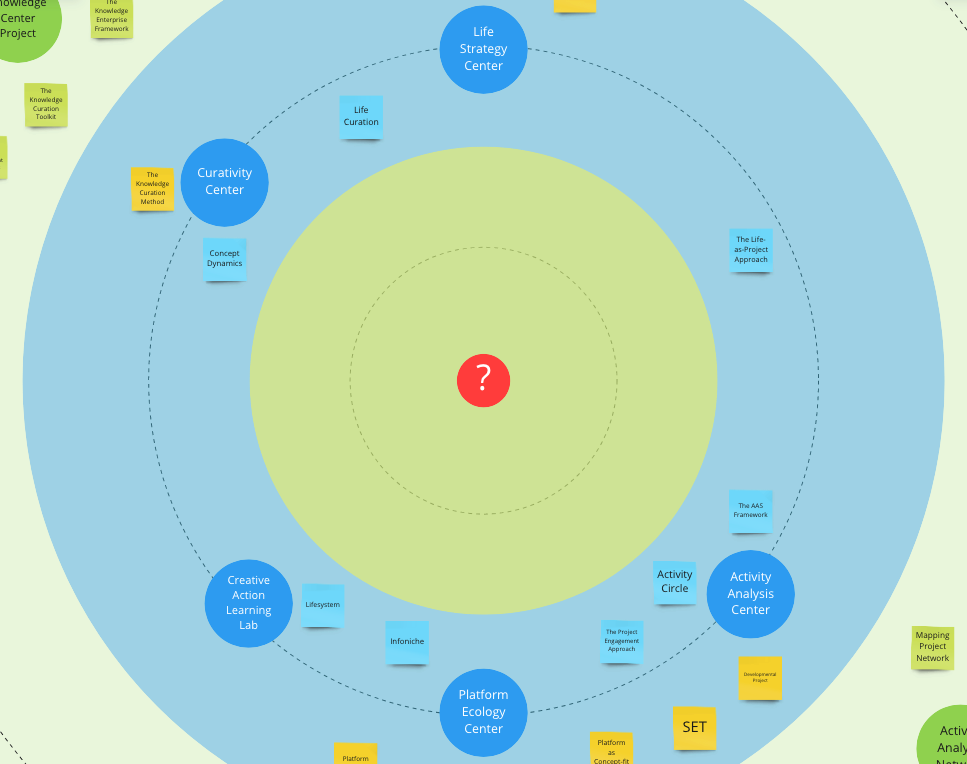
The second step is highlighting a set of similar ideas. See the diagram below.
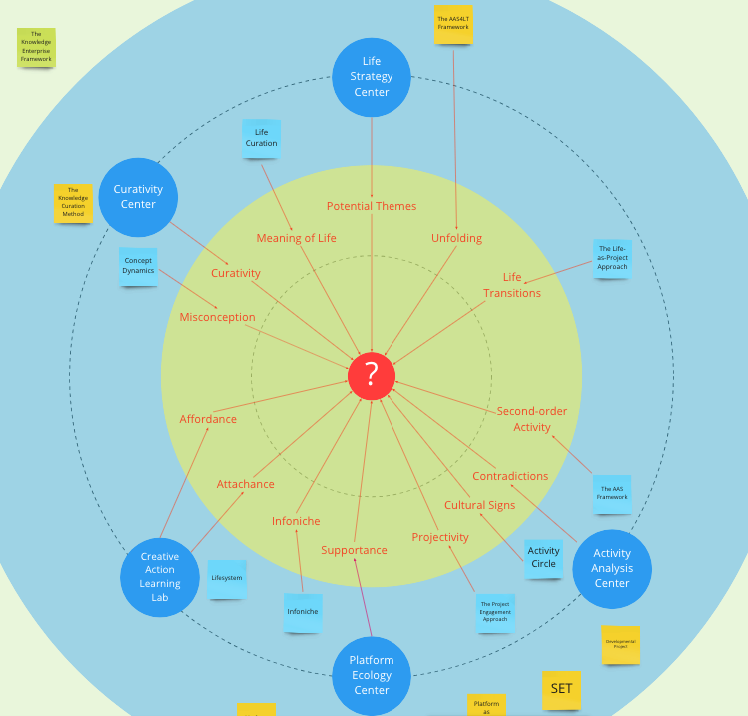
The third step is to find a word or a phrase to name the similarity of all the above ideas.
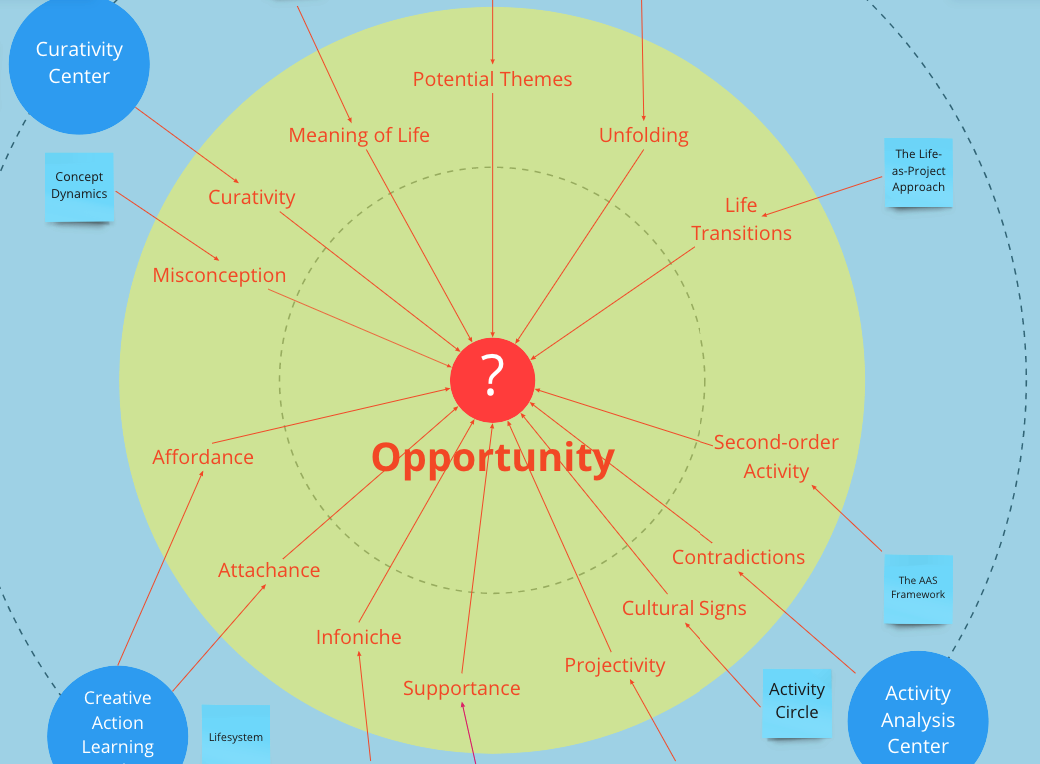
In this test, I discovered a new theme called Opportunity.
Two weeks ago, I discussed the theme of "Opportunity" with my mentor. The discussion is about the future of the Ecological Practice approach.
This idea is not new. I have developed a framework for connecting the Ecological Practice approach and the theme of "Opportunity" in Oct 2021.

In order to explain the value of the ecological practice approach, I adopt the concept of Opportunity as mediation and redefined it as the formula below:
Opportunity = From a perspective (X), You (U) could do things (Y) with an object (Z).
The X formula is a way of building heuristic tools. Some authors also use this method to name their books. For example, the physicist Albert-László Barabási is best known for his work in the research of network theory. He published a book titled The Formula: The Universal Laws of Success in 2018. Ronald F. Ferguson and Tatsha Robertson published The Formula: Unlocking the Secrets to Raising Highly Successful Children in 2020. Though these two books are based on scientific research, they are intended to be written for ordinary readers.
For me, the Opportunity Formula is a way of connecting Meta-theory (mTheory) and General Practice (gPractice).
By mapping the thematic landscape, I found more support from other knowledge centers.
This is a significant insight!
10. Exploring Possible Projects
I made the v1 of the above Thematic Landscape diagram on Sept 2, 2022.
On Sept 5, 2022, I made the v2 of the diagram and the only new thing is the Life Engagement Program and the Biographical Engagement Project. See the diagram below.
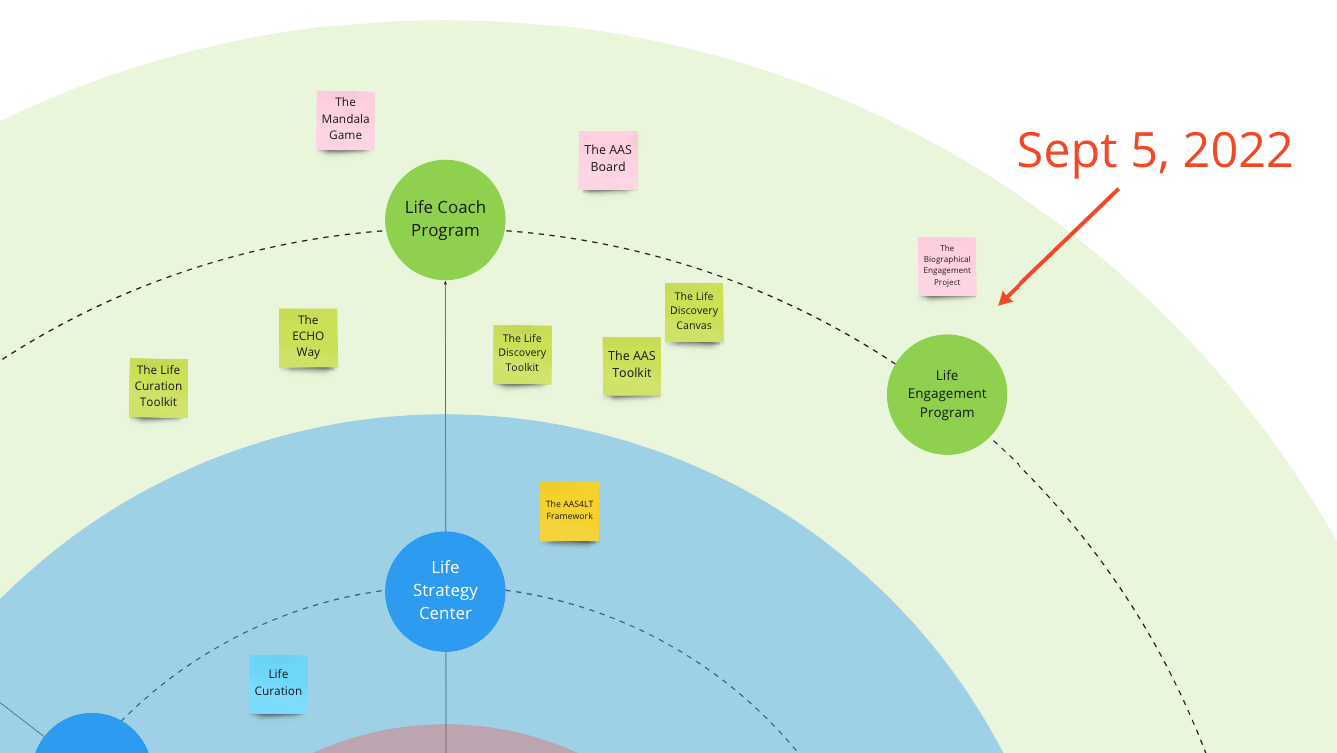
Why did I add the Biographical Engagement project to the diagram?
I was attracted to biographical studies since I wrote my first learning autobiography in 2015. In order to help a friend, I developed a framework called Career Landscape which is inspired by Activity Theory, Communities of Practice, and other ideas in 2016. In Nov 2020, I reconstructed the framework with more theoretical resources and the outcome was a new method named the Life-as-Activity approach (v0.3).
On the other side, I often read intellectual biographies of psychologists in the past years. This year, I moved to read biographies about other knowledge creators from other fields.
On Sept 5, 2022, I read a paper which was written by my mentor. The paper mentioned Paul Ricoeur's ideas. In order to learn more about these ideas, I visited the Standford Encyclopedia of Philosophy and read a page about Paul Ricoeur.
Immediately I was attracted to the following piece.
In the course of developing this anthropology, Ricoeur made several major methodological shifts, partly in response to changes in his intellectual setting as new developments came to speak to the topics he was dealing with, sometimes in ways that challenged his own approach, partly as he pursued questions that had arisen as a result of his published work or that had not yet been considered there.
I realized that Ricoeur's story is a good example of "Attachance" which is a core idea of my work: the Ecological Practice Approach. From the perspective of the Project Engagement approach, Ricoeur's several major methodological shifts mean "Moving between Thematic Spaces".
In fact, the concept of "Attachance" echoes the notion of "Moving between Thematic Spaces".
This experience led to a new significant sight:
I can use the Life Strategy Center to host a project about reading biographies.
The name of the Biographical Engagement project is inspired by the Project Engagement approach. We will consider "reading", "mapping", and "discussing" a person's biography as a "Project". The whole process is called "Biographical Engagement".
You can find more details in a Linkedin post.
This is a great example of using the Thematic Landscape Map to Exploring Possible Projects. As mentioned in the last section, we often need to figure out what we should do for the next project. Since Landscape Map displays our Present, we can explore our new ideas about the next projects with existing projects.
A new project will expand our Project Network. We can use the Thematic Landscape Map to review the potential connections between new projects and existing projects.
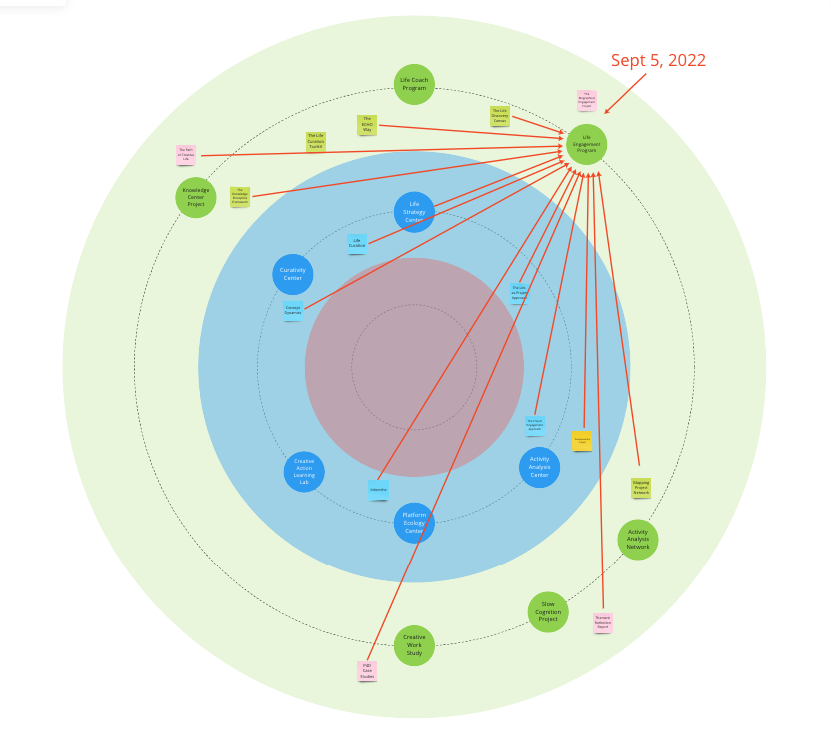
The notion of Project Network is part of the perspective of the Project Engagement approach. By using the Thematic Landscape Map, we can manage the complexity of the dynamic Project Network.
11. Conclusion
The method of Mapping Thematic Landscape offers a new approach to visualizing multi-level thematic spaces.
Though I used my own story as an example, it can be used for discussing a creator (for example, Niklas Luhmann), a creative team, or a creative community.
It also can be used to understand a landscape of a theme or a group of themes. This idea echoes the Thematic Space Canvas.
We can also compare Mapping Thematic Landscape with the Model of "Project Network".
The model of “Project Network” is a multiple-level network that considers 1) a network of Themes, 2) a network of Projects, and 3) a network of People.
- All theoretical approaches and frameworks belong to the network of themes.
- All real activities such as developing a toolkit, designing a canvas, and hosting a program, are part of a network of projects.
- All things about people’s biogeography are located in the network of People.
By using the model of “Project Network”, I designed the following diagram to visualize the complexity of the above ten themes.
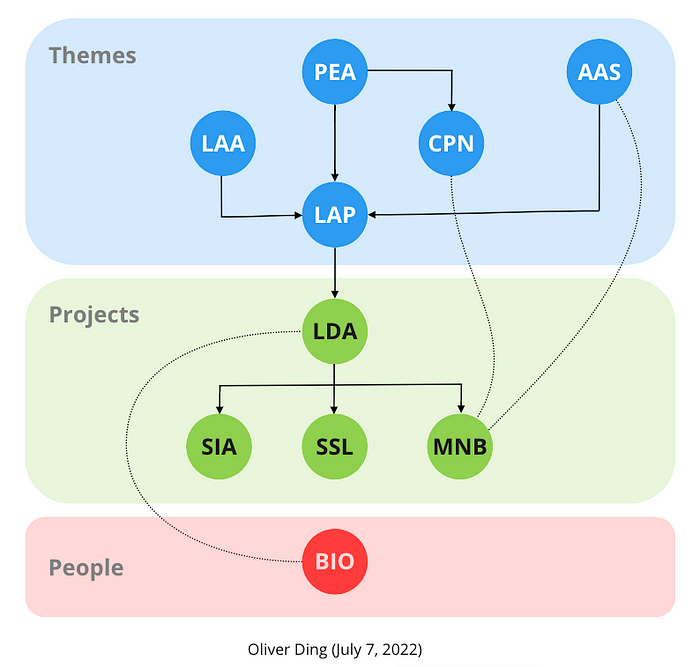
The diagram is a map of the archive of my six-month journey in developing the Life-as-Project approach. You can find more details in Life Discovery: Biography, Journey, Program (and a possible book, Part 3).
The above diagram doesn't offer space for pasting data. However, the Thematic Landscape can allow us to dive in.
Though I didn't consider People in the above case study of Mapping Thematic Landscape, we can add People to the process if we want to do. In this way, the Thematic Landscape is an expanded applicational version of the model of "Project Network".
Finally, we can consider Mapping Thematic Landscape as a new member of the Project Engagement approach.
